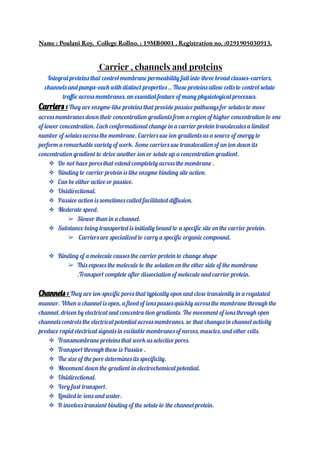Carrier, channels and proteins by Poulani Roy
•
0 gostou•12 visualizações
This is the most precise & descriptive slide on carriers,channels & proteins.Hope this short document with colourful images will definitely give boost your preparation!!! Cheer up hit the like !!
Denunciar
Compartilhar
Denunciar
Compartilhar
Baixar para ler offline

Recomendados
Recomendados
Mais conteúdo relacionado
Mais procurados
Mais procurados (20)
Semelhante a Carrier, channels and proteins by Poulani Roy
Semelhante a Carrier, channels and proteins by Poulani Roy (20)
transport_across_cell_membrane_cellular_transport.pptx

transport_across_cell_membrane_cellular_transport.pptx
Mechanism of transport of small molecules across membrane.pptx

Mechanism of transport of small molecules across membrane.pptx
Cell Membrane Transport/Factors/Transport of Substances

Cell Membrane Transport/Factors/Transport of Substances
Lecture 4 (transport of substances through plasmallema)

Lecture 4 (transport of substances through plasmallema)
Último
Último (20)
Stunning ➥8448380779▻ Call Girls In Panchshil Enclave Delhi NCR

Stunning ➥8448380779▻ Call Girls In Panchshil Enclave Delhi NCR
Disentangling the origin of chemical differences using GHOST

Disentangling the origin of chemical differences using GHOST
Chemical Tests; flame test, positive and negative ions test Edexcel Internati...

Chemical Tests; flame test, positive and negative ions test Edexcel Internati...
High Class Escorts in Hyderabad ₹7.5k Pick Up & Drop With Cash Payment 969456...

High Class Escorts in Hyderabad ₹7.5k Pick Up & Drop With Cash Payment 969456...
PossibleEoarcheanRecordsoftheGeomagneticFieldPreservedintheIsuaSupracrustalBe...

PossibleEoarcheanRecordsoftheGeomagneticFieldPreservedintheIsuaSupracrustalBe...
Labelling Requirements and Label Claims for Dietary Supplements and Recommend...

Labelling Requirements and Label Claims for Dietary Supplements and Recommend...
VIRUSES structure and classification ppt by Dr.Prince C P

VIRUSES structure and classification ppt by Dr.Prince C P
Pests of mustard_Identification_Management_Dr.UPR.pdf

Pests of mustard_Identification_Management_Dr.UPR.pdf
All-domain Anomaly Resolution Office U.S. Department of Defense (U) Case: “Eg...

All-domain Anomaly Resolution Office U.S. Department of Defense (U) Case: “Eg...
Pulmonary drug delivery system M.pharm -2nd sem P'ceutics

Pulmonary drug delivery system M.pharm -2nd sem P'ceutics
Biopesticide (2).pptx .This slides helps to know the different types of biop...

Biopesticide (2).pptx .This slides helps to know the different types of biop...
Carrier, channels and proteins by Poulani Roy
- 1. Name : Poulani Roy. College Rollno. : 19MB0001 . Registration no. :0291905030913. Carrier , channels and proteins Integral proteins that control membrane permeability fall into three broad classes—carriers, channels and pumps—each with distinct properties .. These proteins allow cells to control solute traffic across membranes, an essential feature of many physiological processes. Carriers : They are enzyme-like proteins that provide passive pathways for solutes to move across membranes down their concentration gradients from a region of higher concentration to one of lower concentration. Each conformational change in a carrier protein translocates a limited number of solutes across the membrane. Carriers use ion gradients as a source of energy to perform a remarkable variety of work. Some carriers use translocation of an ion down its concentration gradient to drive another ion or solute up a concentration gradient. ❖ Do not have pores that extend completely across the membrane . ❖ Binding to carrier protein is like enzyme binding site action. ❖ Can be either active or passive. ❖ Unidirectional. ❖ Passive action is sometimes called facilitated diffusion. ❖ Moderate speed. ➢ Slower than in a channel. ❖ Substance being transported is initially bound to a specific site on the carrier protein. ➢ Carriers are specialized to carry a specific organic compound. ❖ Binding of a molecule causes the carrier protein to change shape ➢ This exposes the molecule to the solution on the other side of the membrane .Transport complete after dissociation of molecule and carrier protein. Channels : They are ion-specific pores that typically open and close transiently in a regulated manner. When a channel is open, a flood of ions passes quickly across the membrane through the channel, driven by electrical and concentra-tion gradients. The movement of ions through open channels controls the electrical potential across membranes, so that changes in channel activity produce rapid electrical signals in excitable membranes of nerves, muscles, and other cells. ❖ Transmembrane proteins that work as selective pores. ❖ Transport through these is Passive . ❖ The size of the pore determines its specificity. ❖ Movement down the gradient in electrochemical potential. ❖ Unidirectional. ❖ Very fast transport. ❖ Limited to ions and water. ❖ It involves transient binding of the solute to the channel protein.
- 2. ❖ Channel proteins have structures called gates(Open & close pore in response to signals -Light,Hormone binding ) ❖ Only Potassium can diffuse either inward or outward -All others must be expelled by active transport. ❖ Aquaporins: Integral membrane proteins that form water selective channels ➢ allows water to diffuse faster. ➢ Facilitates water movement in plants. Pumps:They are enzymes that utilize energy from adenosine triphosphate (ATP), light, or (rarely) other sources to move ions (generally, cations) and other solutes across membranes at relatively modest rates. They establish concentration gradients between membrane-bound organelles. ❖ To carry out active transport: The membrane transporter(pump) must couple the uphill transport of a molecule with an energy releasing event This is called Primary active transport. ❖ Energy source can be ➢ The electron transport chain of mitochondria . ➢ The electron transport chain of chloroplasts . ❖ Movement against the electrochemical gradient. ❖ Unidirectional . ❖ Very slow. ❖ Significant interaction with solute . ❖ Direct energy expenditure. Fig 1 . Properties of the three types of proteins that transport ions and other solutes across membranes,The triangle represents the concentration gradients of Na+ (blue) and glucose (green) across the membrane.
- 3. Fig 2 : Membrane transport across the plasma membrane-Channels ( passive transport ), Carriers (passive transport) & Pumps (active transport).